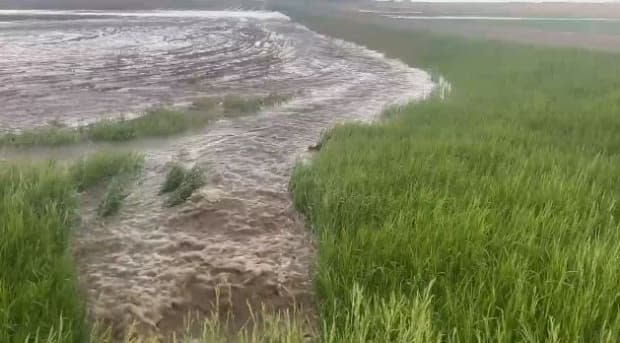Producers experiencing water shortages in southwest Sask.

Farmers and other producers in southwest Saskatchewan are experiencing dry fall weather.
The lack of rain in some areas is causing "moderate to severe on-site water shortages," according to the latest provincial crop report.
"It's just setting us up again for a questionable start for next spring," Garner Deobald, the president of the Saskatchewan Stock Growers Association, said.
Deobald said most places have seen below average snowfall for the last three or four years.
He said the Ministry of Agriculture needs to monitor water quality.
"Water is a critical part of raising any kind of livestock and good quality of water is important," Deobald said.
Some producers may have to forgo fall grazing and bring livestock in earlier than they usually would because of lack of water in those areas, he said.
Producers have been hauling water and supplementing grazing patches to help keep livestock out into the fall.
Deobald said this year's water shortage reminds him of the dry season in the 1980s.
"We're one day closer everyday," said Deobald.
Digging 1,500 feet to find water
"The phone is ringing steady with people dealing with this water shortage," Brody Ellis, one of the owners at All Out Water Well Services and Drilling, said. "In the last couple of years, it has been a huge spike as people's shallow wells have dried up."
Ellis said the company's three drilling rigs are running "round the clock" across the province and that it has already dug at least 100 wells this year.
"I doubt we'll get any rain. Even if we do some now, it won't be an easy thing going into the next year for farmers in southwest Saskatchewan."
Ellis said the problem also exists in northern Saskatchewan — where wells that functioned for more than 100 years have run dry — but that it has long been problem further south.
"By Cadillac near the U.S. border, we are drilling water wells 1,500 feet deep before we found any water."
With no surface or shallow water available in those regions, Ellis said people have to dig deeper to find aquifers. He said the associated costs of digging a well can range anywhere from $1,000 to $100,000.
"It's an added cost for the farmers, but it's a struggle for us too. It's difficult to make profits with the inflationary expenses increasing and labour shortages continuing."
He said the government should continue to provide assistance grants to farmers for such water management projects.

John Pomeroy, the Canada research chair in water resources and climate change at the University of Saskatchewan, said the surface water shortage in southwest Saskatchewan is due to the massive drought last year that essentially "never ended."
"The rains were completely inadequate over this summer and snow pack didn't develop to any great degree in the winters," he said.
"It's more than two years of drought which extended all the way down through the U.S. to Mexico, where there is a mega drought."
'Exceptional rain and snow will help'
Pomeroy said there is not enough water in dugouts for cattle, but that melting of snow packs can alleviate that drought.
"It would have to be above-normal snow packs followed by substantial spring rains to rebuild the deep soil moisture and groundwater reserves," Pomeroy said.
"That's unlikely, but it did happen in Manitoba. They had record rainfall this spring and went from one of the most severe droughts in their history to flooding conditions."

Pomeroy said it is still too early to predict spring conditions for Saskatchewan, as the warming climate means less snow and more rain.
"In southwest Saskatchewan, we'll see more winter rains than snow, and longer summers meaning more evaporation from soil and crops."
While "exceptional rain and snow" would be needed to break the drought, in the longer run Pomeroy worries water management will continue to be challenging.
"It takes long periods of droughts before groundwater [levels] drop. When it is affected, then it is a severe state."

 Yahoo Movies
Yahoo Movies 
